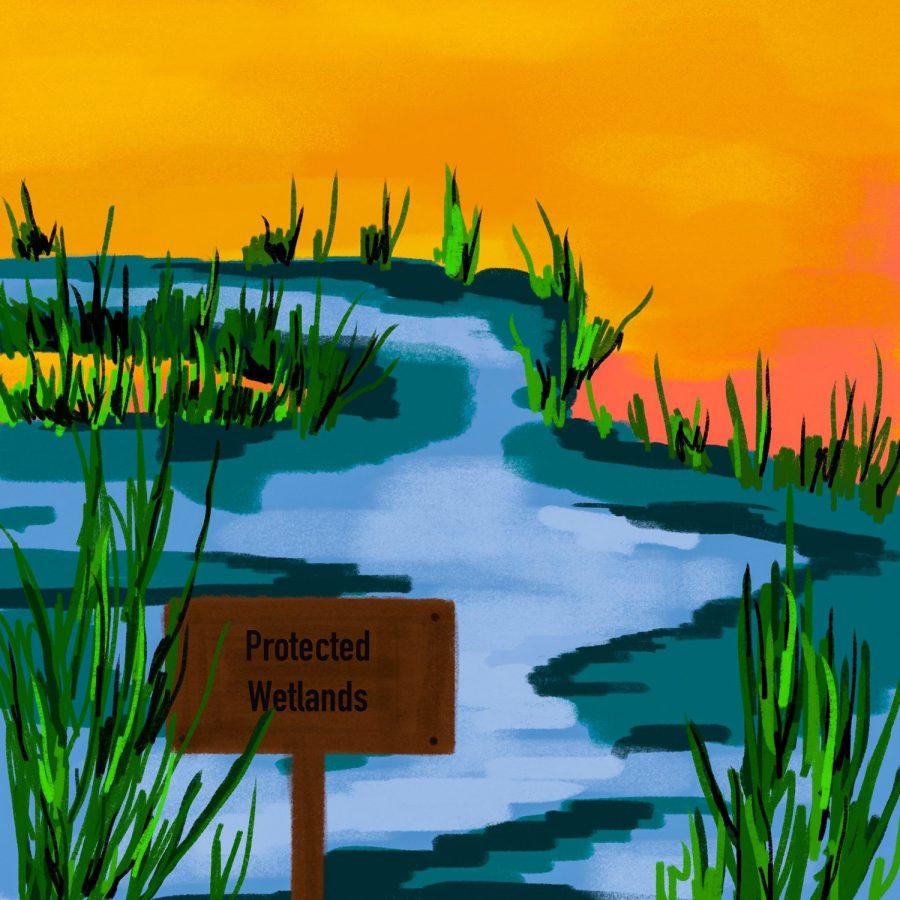Opinion | Trump weakens environmental regulations, leaves streams and wetlands vulnerable
January 27, 2020
In light of the recent impeachment proceedings, all eyes have been on President Donald Trump as Americans follow his trial. The antics in Washington, D.C., have drawn the public’s attention away from any policy updates or changes that are occurring.
However, an important update occurred within the last week — the implementation of a new policy called the Navigable Waters Protection Rule.
This rule — a replacement to the Waters of the United States rule that was repealed in September 2019 — is a massively inferior update to the policy it replaces and is the latest of Trump’s careless environmental policies.
WOTUS was an Obama-era policy that placed federal regulations on many different bodies of water, thus protecting them from sources of pollution such as pesticides and fertilizers that can cause harm to ecosystems if they run off into nearby bodies of water.
The NWPR greatly weakens the original protections laid out in WOTUS by refining what is defined as “waters of the United States.” In this updated policy, protections are stripped from a number of water sources, limiting the scope of protected bodies of water to four categories — “territorial seas and traditional navigable waters; perennial and intermittent tributaries that contribute surface water flow to such waters; certain lakes, ponds, and impoundments of jurisdictional waters; and wetlands adjacent to other jurisdictional waters.”
These categories restrict jurisdiction to a set of water sources that is massively limited and puts far more sources at risk of pollution. The new rule also clarifies which sources and bodies are now excluded from protection, including, but not limited to, groundwater, ephemeral streams and man-made lakes and ponds.
Excluding these waters from the new rule puts vulnerable ecosystems at risk to damage from harmful chemicals and pollutants that can now be disposed of without any federal regulation or interference. The exclusion of ephemeral streams — or streams that flow only after precipitation — from the protected categories is particularly worrisome, as ephemeral streams are vital to the health and overall well-being of river systems.
Changes implemented by the NWPR will seriously impact southwestern regions as these streams are prominent in the mid and southwestern regions of the United States — for example, about 95% of streams in Arizona are ephemeral. As such, without the proper legislative protection, these streams have greater potential to be negatively impacted by pollution. Given that they make up so much of the region’s waterways, states in the mid and southwestern regions would be the most sensitive to the negative effects of the lessened protections.
New Mexico has possibly the most at stake as the NWPR goes into effect. It is estimated that, due to now-limited federal regulations, in addition to a lack of regulations on the state level, 96% of New Mexico’s water bodies and wetlands will be left unprotected.
Also at risk in New Mexico are the major tributaries flowing into the Rio Grande and the Santa Fe River, the latter being a main source of drinking water for the city of Santa Fe. As such, unregulated pollution in the connected tributaries could seriously impact the health and safety of citizens by contaminating their drinking water.
Wetlands are proven to positively affect the quality of waters found downstream from them by nature of their function as a natural filter or buffer that helps to eliminate pollution. However, under the NWPR’s narrowing scope of jurisdiction, only “adjacent wetlands,” or those that directly border or have a direct surface connection to a body of water that is protected by federal jurisdiction, will maintain their protected status. This is concerning, especially as wetlands are known to influence the condition of nearby waters, even when they lack a direct surface connection.
Another concerning aspect of the NWPR is Trump’s apparent misunderstanding of the policy’s consequences. In an address at the annual convention of the American Farm Bureau Federation, Trump stated that “[Waters of the United States] was a rule that basically took your property away from you.”
This statement paints a twisted view of the former policy, attempting to make out the NWPR as a win for farmers and industries as it supposedly gives their land back to them and frees them from federal interference. However, the original WOTUS rule didn’t necessarily restrict the use of land, and according to Section 404 of the Clean Water Act, many activities are generally permitted in the presence of wetlands. For example, the EPA does not restrict farmers from performing typical agricultural functions — such as plowing, harvesting and maintenance of dams, ponds or ditches — on protected lands.
Due to this fact, Trump’s claim that the WOTUS rule infringed on landowners’ access to their own property is invalid, especially because the actual jurisdiction on taking land or restricting access comes from a different piece of legislation.
While Trump’s implementation and portrayal of the NWPR may bolster the faith his political base has in him — specifically the farmers, industries and other landowners who may feel they have regained control over their land — it will inevitably have negative effects on areas that are susceptible to pollution and damage from now-unregulated pollution.








